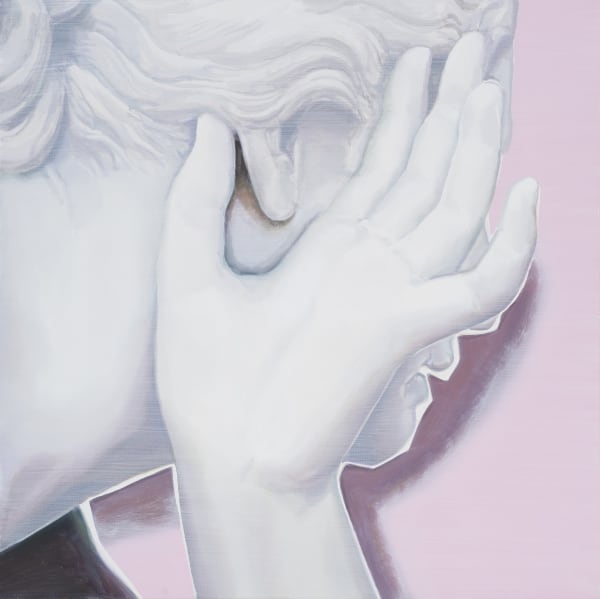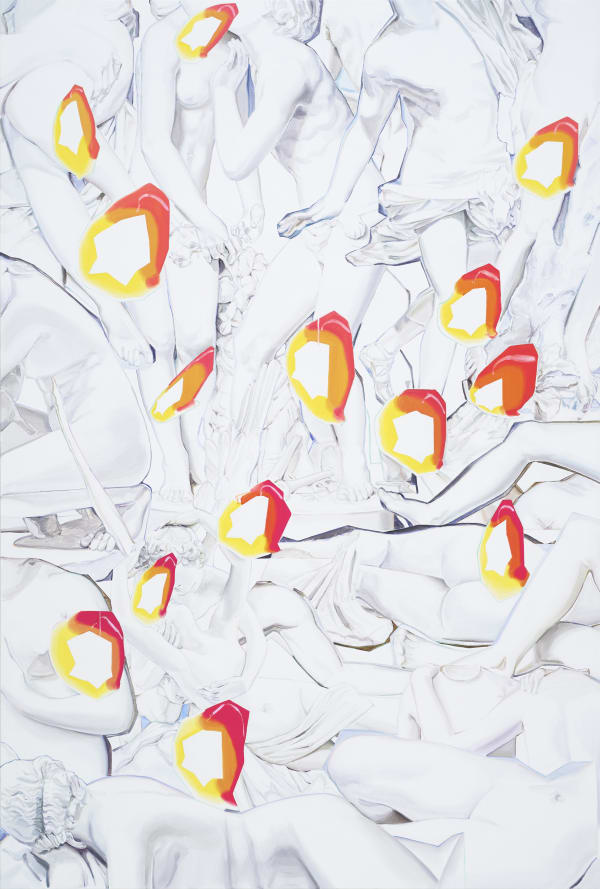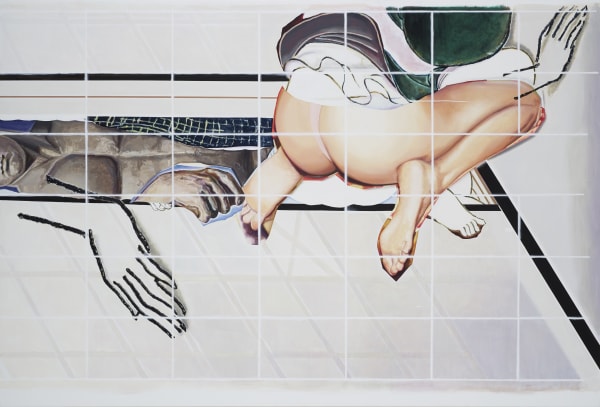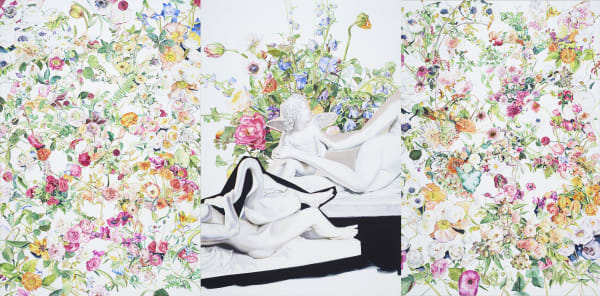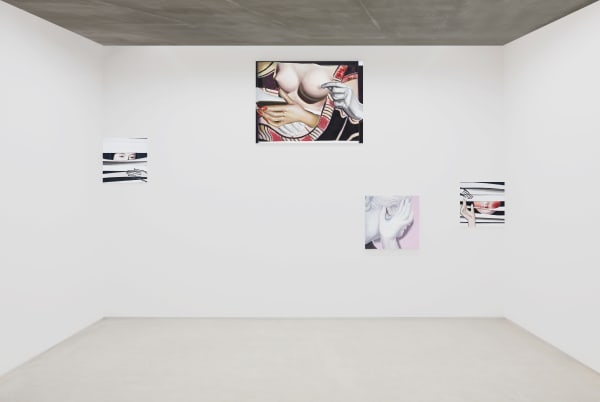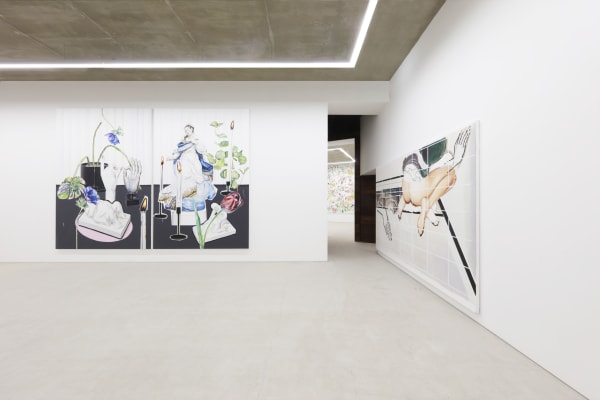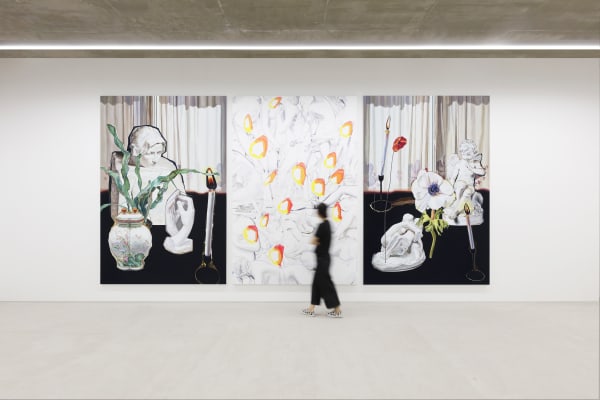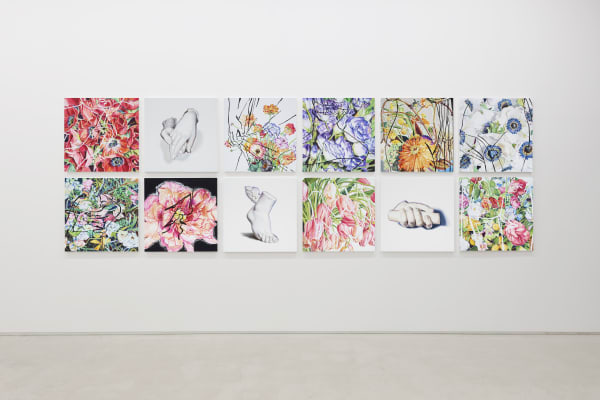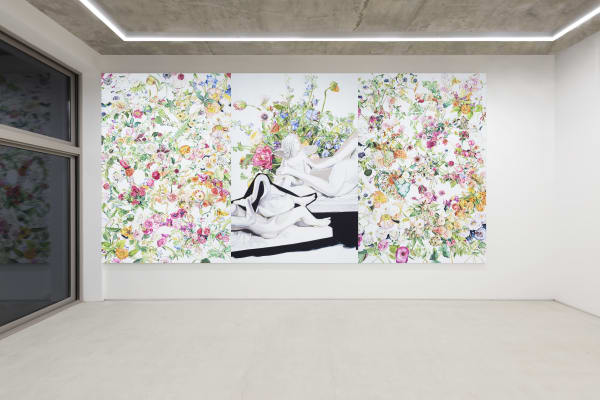SPRING PAINTING: 김수연 Suyeon Kim
2017년의 일이다. 김수연은 대만의 한 레지던시에 참여했고, 서점을 돌아다니다 일본의 춘화집을 샀다고 한다. 춘화(春畫)는 남녀 간의 성교하는 모습을 담은 그림이다. 이 폐쇄적인 성향의 사건을 이미지로 폭로하는 것이 춘화이며, 여기서 사랑의 욕망은 몸으로 요약된다. 그리고 그 몸은 무엄할 정도로 직설적이다. 나체는 고전 미술에서도 자주 등장하는 소재지만, 대부분 신화나 역사에 기대어 은밀하게 드러난다. 춘화에서 몸은 결정적 장면을 묘사하는 하나의 현실이며, 이야기의 시작도 끝도 아닌 육체적 쾌락 자체를 의미한다. 그런데 춘화집에서 작가의 눈길을 끈 것은 맞잡은 두 손, 이불 속에서 살짝 드러난 겹쳐진 두 발의 모양이었다고 한다. 그 작은 동작에서 상대에 대한 사랑이 느껴졌다는 것이다.
김수연은 2017년 처음 춘화를 소재로 작업했을 때 순간의 쾌락 안에서도 존재하는 사랑의 감정을, 그 애틋한 마음을 표현하려고 했다. 그림에는 서양의 고전 조각이 등장한다. 그는 몇 년 전 유럽의 미술관에서 봤던 고전 조각의 아름답고 우아한 몸체와 대리석의 매끄러운 표면에 매료되었다고 한다. 그림 안에 고전 조각의 이미지를 넣은 것은 신의 이름을 빌려 만들어진 조각을 통해 유한하고 속된 인간의 사랑을 무한하고 성스러운 것으로 표현하고 싶었기 때문이다. 수집된 춘화와 고전 조각의 이미지 그리고 우키요에 풍의 무늬로 구성된 그림은 곧 변화하게 된다. “만약 내가 춘화를 그리는 화가라면, 나는 무엇을 어떻게 그릴 것인가?” 이 새로운 가정은 그림에서 타인이 그린 춘화의 이미지를 슬쩍 제거하게 했다.
이후 제작된 대형 캔버스에 그려진 4점의 <SP9>, <SP10>, <SP11>, <SP12>는 꽃과 조각 그리고 본인이 만들었던 종이 조형물로 구성되어 있다. 처음으로 꽃을 그렸다는 김수연은 꽃 중에서도 뿌리가 없는 장식용 꽃을 선택했다. 남녀의 사랑이 마치 다음 생을 기약할 수 없는, 시들면 죽어버리는 장식용 꽃처럼 느껴졌기 때문이다. 서양의 고전 조각은 성스러운 사랑의 상징으로서 여전히 자리를 꿰차고 있다. 작가가 만들었던 촛농이 떨어지지 않는 촛불 조형물은 사랑이 영원히 식지 않길 바라는 그의 마음이다.
앞서 설명한 작품에서는 오랫동안 유지했던 작업 방식의 균열이 감지된다. 그동안 김수연은 그림의 주제가 되는 대상을 본인이 직접 종이 조형물로 만들고, 그것을 세밀하게 묘사했다. 초상화처럼 그림의 중심을 차지하던 종이 조형물은 수집된 꽃과 조각상의 이미지에 자리를 내어 준다. 암막 커튼이나 테이블과 같은 가상의 무대 설정은 여전히 공간과 사물을 구분하지만 그림의 요소들이 갖는 각기 다른 시점과 빛의 방향, 비현실적인 비율과 초현실적인 배치 그리고 사물 주변을 거칠게 잘라버린 흔적은 하나의 시점으로 그림의 화면을 통합했던 이전의 (초상화 같은) 정물화와 구별된다.
3개의 캔버스로 이뤄진 <SP13>은 삼면화 연작이면서 개별적인 작품이다. 이 그림에선 자신이 만들었던 종이 조형물은 모두 사라진다. ‘조형물을 만들어 그림으로 그린다’는 제작 방식은 이제 성립되지 않는다. 고전 조각과 장식용 꽃은 더욱 부각된다. 애틋하지만 신랄한 사랑의 실체는 아름답지만 뿌리가 없이 꺾여진 꽃이, 우아하지만 인간이 아닌 신의 몸이 증언한다. 삼면화에서는 작화법의 변화도 보여진다. 지금까지 김수연은 대상을 여러 번 덧칠하며 꼼꼼하게 묘사했다면, <SP13>에서는 마치 수채화처럼 한 번의 필체로 가볍고 맑게 그려냈다. 3m에 육박하는 대형 캔버스에 그림을 그리다 보니 하나의 대상에만 몰두하기 어려웠을 것이다. 화면을 채워 나간다는 것 자체에 큰 의미가 있다. 그리고 이것은 작가가 애정을 듬뿍 담아 만들었던 종이 조형물이 사라진 것에도 연유할 것이다. 그림으로 온전히 부활시켜야 할, 몰두해야 할 대상이 사라졌기 때문이다. 어떤 의미에서 그는 이번에야말로 진정 ‘그림을 그렸다.’
춘화를 모티프로 한 이번 전시의 주제는 사랑 그 이상도 그 이하도 아니다. 김수연은 스스로 사랑이라는 주제가 관념적이고 보편적이며 지루하다고 자백한다. 그러나 인간에게 사랑보다 중요한 것은 없다고 말한다. 그는 도발적인 춘화의 이미지에서 순간적일지라도 작고 소중한 사랑을 발견하고 이것을 추루하지 않게 그리고자 노력했다. 원래 화가의 일은 순간을 영원하게 하는 것, 소중한 것이 사라진 빈 곳을 이미지로 채우는 것이다. 오로지 화가만이 그렇게 할 수 있고, 그렇게밖에 할 수 없다.
It happened in 2017. Suyeon Kim was in Taipei as an artist in residence when her exploration of bookstores won her a Japanese book of erotic depictions. Chunhwa (春畫), pronounced shunga in Japanese, are paintings of a man and a woman engaged sexually. Literally meaning spring paintings as euphemism for more licentious topics, the paintings reveal a very human behavior universally shared yet unspoken; the desire for love expressed in flesh. Its sheer candidness almost bears gravitas. Nudes were common even in classical arts, but they had been more discreet and veiled under mythology and history. The carnal flesh in chunhwa is reality expressing itself in its own moment; of sheer physical bliss. It is momentous, yet partakes in neither beginning nor end of a story. When the artist's gaze was caught, it was between clasped hands, and a pair of feet one upon the other, barely under the cover. It felt like love, she recalls.
When Suyeon Kim began experimenting with chunhwa in 2017, she sought means to capture the ephemeral moment with its sentiments of affection and transience. Her paintings featured chunhwa images scrapped here and there, alongside classical sculptures of the West. She was captivated by the fine marble of the pale elegant sculptures encountered at an art museum visit, some years ago in Europe. The image of those sculptures were added in her paintings to loan from the deities that inspired their creation; to borrow the sublimation of human love, otherwise the decadent and finite. Her collection of chunhwa, images of classic sculptures, and images composed in the style of ukiyo-e (浮世絵 - woodblock prints and paintings of such subjects as female beauties; lit.: images of the floating world) soon changed. To the self-imposed question of "If I were a chunhwa painter, what would I draw, and how would I go about that?" she answered by surreptitiously removed chunhwa that were not of her own.
The <SP9>, <SP10>, <SP11>, <SP12> 4-piece that she later presented on large canvas features flowers, sculptures, and her personally-created paper figures. According to Kim, it was the first time she painted flowers, and they happened to be lifelike artificial blossoms. It was intentional, as the artist felt that even the most passionate of love between man and woman could not pledge anything beyond this life; temporary by nature, like flower-decorations that wilt and die. The classical sculpture of the West is still recognized as symbol of divinity, of love. The candle sculpture was created in the same vein; the wax melts not, like the artist's longing for love that is never extinguished.
Above works deviate from the artist's more established means of approach. Suyeon Kim painted delicate images of her own paper sculptures; sculptures depicting subjects that she intended to paint. The paper sculptures which had occupied the center of her canvas have been now vacated in favor of collected images of flowers and sculptures. The faux-theatrical prop setup of curtains and the table remain to separate space and objet, but the dissimilar perspectives and light directions of compositional elements, unrealistic proportions and surreal placement of objets, the rough-cut edges around them, no longer focus the gaze as the artist's former portrait-like still-life works had.
<SP13> is composed of three separate canvases. Each separate, but also part to a three-panel sequence. No longer are her paper sculptures seen here. Her approach of creating sculptures to be painted is no more. Classical sculptures and ornamental flowers are even more prominent. It is not the flesh that bears testimony to the aesthetic essence of love, the strong feelings of bittersweet affection. It is the rootless flower and the marble bust of an unnamed god. The artist's three-panel work also features changes to her compositional approach. <SP13> is painted with light strides of the brush, which stands in contrast to her past works that were meticulously detailed and layered. Perhaps it was the sheer size of 3-meter real-estate that forbade devotion to a lone objet. Fill the canvas she did. That is significant in itself. Her future works will perpetuate long past her paper sculptures that she had been so partial toward. Suyeon Kim's works have been in some sense, emancipated from objects of devotion, of mediation, and wholesome resurrection. So in a sense, this is her first "real" painted art.
Chunhwa is the motif of this exhibition; love its theme. Nothing is given or taken from that theme. Suyeon Kim admits working with the theme of love itself can be trite, ideological, and maybe even boring in some facetious and ironic way. She is also quick to add that despite that, love remains paramount to humanity. She found fleeting moments of cherished love between the licentious lines of chunhwa. She adopted those moments and sought to present them on her own canvas sans scandal. What the painter does is draw out moments; sometimes to eternity, sometimes to repopulate lost moments with images. Only the painter can do it that way, and that is the only way it is done.
